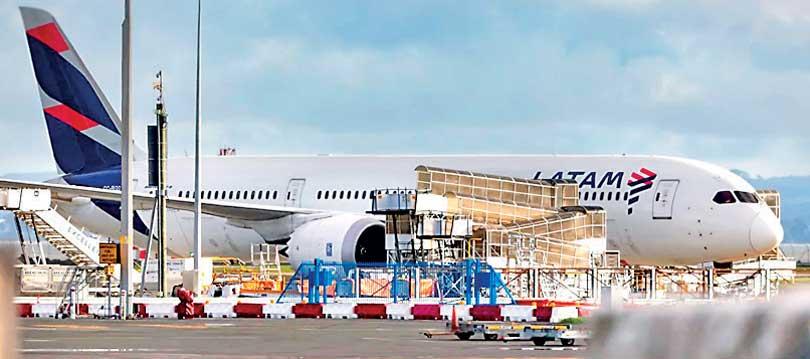Reply To:
Name - Reply Comment

Latam Airlines Boeing 787 Dreamliner plane that suddenly lost altitude mid-flight at Auckland International airport in New Zealand (PHOTO: BRETT PHIBBS/AFP)
The movement of a pilot’s seat on a Boeing 787 Dreamliner may have been behind the aircraft’s sudden nosedive during a flight on Monday, March 11, 2024 that caused the injury of at least 50 passengers, according to an aviation publication.
The Latam flight had departed from Sydney, Australia and was heading for Auckland, New Zealand, when it “froze” in mid-air and went into free fall, throwing passengers up in the air, with some hitting their heads against the ceiling.
A flight deck seat is now one focus of the investigation into the incident, Air Current reported, saying it was understood the seat movement was “pilot induced, not intentionally”, citing a senior airline safety official.
“The seat movement caused the nose down” angle of the aircraft, the publication said, citing another anonymous source, who added that the possibility of an electrical short was also under review.
Boeing is expected to release a message to 787 operators regarding the incident, Air Current reported, in a sign a fleet-wide issue could be involved – though it said the specific topic of the message was not known.
It is the latest in a series of events that have put the US plane giant Boeing under intense scrutiny, including a door plug being blown off an Alaska Airlines 737 in January.
When asked to comment on the Air Current report, Boeing told i it would defer to air safety investigators.
In a statement it added, “We are thinking of the passengers and crew from flight LA800 and we commend everyone involved in the response effort.
We are in contact with our customer and Boeing stands ready to support investigation-related activities as requested.”
Chile’s aviation regulator, which is leading the inquiry, because it involves a Chilean airline flying in international airspace, said the probe “just got underway” and its investigators had arrived in New Zealand.
Latam said it “continues to work in co-ordination with the authorities to support the investigation” and said it was not appropriate to comment on speculation that has circulated.
The cause of the flight’s apparent sudden change in trajectory has not yet been explained. Safety experts say most aeroplane accidents are caused by a cocktail of factors that need to be thoroughly investigated.
(IENEWS.CO.UK)
A “surprise”, says Prof. Gratton
Cranfield University Associate Professor of Aviation and Environment Guy Gratton told i last week that Monday’s accident involving the 787 was a “surprise”, despite a series of worrying incidents with Boeing aircraft.
Professor Gratton said, “There is a particular history with the Boeing 737 Max family of aircraft, that’s a completely different aircraft design, albeit from the same company.”
In 2018, 189 people died when a 737 Max 8 crashed in Indonesia, just months before another crashed in Kenya, killing 157 people.
“Boeing 787 has a great safety track record, so there’s nothing that makes you look at this and say, ‘Oh, no, not another one.’ This is a very surprising accident,” said Professor Gratton.
He said the Auckland-bound 787’s nosedive may have been down to the weather, technical failure of the aircraft or mishandling by the crew.